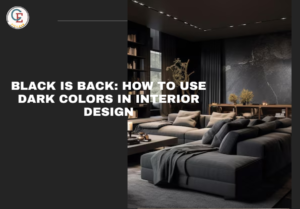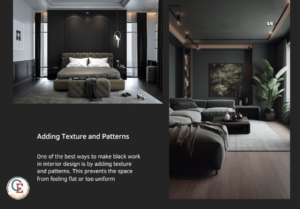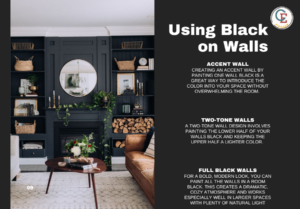Black has always been a classic color in fashion, but now it’s making a strong comeback in interior design too. Many people once thought that dark colors, especially black, made spaces feel small, gloomy, or even depressing. But that’s not true anymore. When used correctly, black can add sophistication, warmth, and a modern touch to any space. Whether it’s a small apartment or a large house, black can work wonders. In this blog, “Black is Back : How to Use Black Colors in Interior Design”. We will explore how you can use dark colors, especially black, in interior design to create stunning and cozy spaces.
- Understanding the Power of Black
Black is a bold and powerful color. It can create a dramatic effect in any room, making it feel stylish and elegant. But why is black so powerful? Here are a few reasons:
- Versatility: Black goes with almost everything. It can be paired with other colors, textures, and materials to create different styles, from modern to classic.
- Contrast: Black creates a strong contrast, which can highlight other elements in the room, like furniture, artwork, or architectural details.
- Depth: When used on walls, black can add depth to a room, making it feel more expansive and layered.
- Choosing the Right Shade of Black
When it comes to incorporating black into your interior design, selecting the right shade is crucial. Black is not just a single color but a spectrum of shades, each with its own unique impact on a space. From deep, inky blacks that make a bold statement to softer, charcoal tones that add subtle sophistication, the shade you choose can dramatically influence the mood and style of your room. Understanding the nuances of different black shades will help you make informed decisions that enhance your interior design, ensuring that your space feels both stylish and balanced.
1. Pure Black
- Description: This is the darkest and most intense shade of black, often referred to as “jet black” or “true black.” It’s a bold, solid color with no hints of other tones.
- When to Use: Pure black is ideal for making a strong, dramatic statement. It works well as an accent color on walls, furniture, or decor pieces. It’s perfect for creating focal points in a room.
- Best Pairings: Pair pure black with bright colors like white or metallics like gold and silver for a striking contrast. This combination is great for modern, minimalist, or industrial-style spaces.
2. Charcoal Black
- Description: Charcoal black is a softer, more muted shade of black with a touch of gray. It’s less intense than pure black, offering a more understated look.
- When to Use: This shade is perfect for larger areas like walls or floors, as it adds depth without overwhelming the space. Charcoal black is also a great choice for creating a cozy and inviting atmosphere in living rooms or bedrooms.
- Best Pairings: Pair charcoal black with lighter grays, warm neutrals, or soft pastels for a balanced and soothing look. It also works well with natural materials like wood and stone.
3. Graphite Black
- Description: Graphite black is another soft shade of black that has a slightly metallic or shimmery quality. It’s often used in finishes that require a bit of sheen or texture.
- When to Use: This shade is ideal for spaces where you want to add a touch of luxury without going too dark. It works well on furniture, kitchen cabinets, or accent walls where you want a subtle yet sophisticated effect.
- Best Pairings: Graphite black pairs beautifully with jewel tones like emerald green or sapphire blue, as well as with metallic accents like brass or copper.
4. Matte Black
- Description: Matte black is a flat, non-reflective shade of black. It absorbs light rather than reflecting it, giving it a smooth and velvety appearance.
- When to Use: Matte black is perfect for creating a modern, minimalist look. It’s often used in contemporary interiors where a sleek and understated aesthetic is desired. Matte black is also great for highlighting textures and shapes in a room.
- Best Pairings: Pair matte black with soft textures like velvet or wool, and combine it with other matte or natural finishes like wood, stone, or concrete. It’s also excellent for spaces with plenty of natural light.
5. Onyx Black
- Description: Onyx black is a deep, rich shade of black with a hint of blue or green undertones. It has a luxurious and slightly mysterious feel.
- When to Use: This shade is ideal for creating a moody, elegant atmosphere, especially in spaces like dining rooms, bedrooms, or home offices. Onyx black can add a touch of drama and sophistication without being too overpowering.
- Best Pairings: Pair onyx black with jewel tones, deep greens, or rich purples for a luxurious and refined look. It also works well with gold or brass accents to add warmth and contrast.
6. Ebony Black
- Description: Ebony black is a dark, rich black with brown undertones. It’s a warm shade of black that adds depth and richness to a space.
- When to Use: This shade is perfect for spaces where you want to create a cozy, inviting atmosphere. It works well in living rooms, libraries, or study areas. Ebony black is also great for wooden furniture or cabinetry, adding a touch of elegance and warmth.
- Best Pairings: Pair ebony black with warm neutrals like beige, taupe, or cream. It also complements natural wood tones, leather, and earthy accents.
How to Choose the Right Shade of Black
Choosing the right shade of black for your space depends on several factors, including the room’s size, lighting, and the overall mood you want to create. Here are some tips to help you make the right choice:
- Consider the Room’s Size and Natural Light
-
- In smaller rooms or spaces with limited natural light, opt for softer shades of black like charcoal or graphite. These shades will add depth without making the room feel too dark or cramped.
- In larger rooms or spaces with plenty of natural light, you can go bolder with pure black or matte black. These shades can create a striking contrast and make the space feel more defined.
- Think About the Mood You Want to Create
-
- For a cozy and inviting atmosphere, choose warm shades of black like ebony. These shades work well in living rooms, bedrooms, or study areas where comfort and warmth are essential.
- For a more modern, sleek, or dramatic look, opt for pure black, matte black, or onyx black. These shades are perfect for creating a bold statement and adding sophistication to your space.
- Test the Shade in Your Space
-
- Before committing to a shade of black, test it in your space by painting a small section of the wall or using sample boards. Observe how the color looks at different times of the day and under different lighting conditions.
- Consider how the shade interacts with other colors, textures, and materials in the room. This will help you see how the black will look in your specific environment.
- Consider the Finish
-
- The finish of the paint can also affect how the shade of black looks in your space. Matte finishes are great for creating a smooth, modern look, while glossy or satin finishes can add a touch of luxury and reflect light.
- If you’re using black on furniture or cabinetry, consider how the finish will hold up over time. Matte finishes may require more maintenance, as they can show smudges and fingerprints more easily.
- Using Black on Walls
Accent Wall
Creating an accent wall by painting one wall black is a great way to introduce the color into your space without overwhelming the room. This technique draws attention to a specific area, like the wall behind your bed, sofa, or fireplace, making it a focal point. It adds depth and drama to the room, creating a stylish contrast with the other, lighter-colored walls.
Two-Tone Walls
A two-tone wall design involves painting the lower half of your walls black and keeping the upper half a lighter color. This method adds visual interest and can make your room feel taller and more spacious. It’s a simple way to incorporate black into your decor while still maintaining a balanced and airy feel.
Full Black Walls
For a bold, modern look, you can paint all the walls in a room black. This creates a dramatic, cozy atmosphere and works especially well in larger spaces with plenty of natural light. When using black on all walls, it’s important to balance the dark color with lighter furniture, decor, and good lighting to keep the room from feeling too dark or closed in.
Black with Textures
Instead of using plain black paint, consider black walls with textures, like black wallpaper with subtle patterns or textured finishes. This adds depth and interest to the walls, making the room feel more dynamic and sophisticated. Textured black walls can make a strong statement while still being visually engaging.
Half Wall or Wainscoting
Painting the bottom half of your wall black, or using black wainscoting, is another subtle way to introduce black into your room. This approach adds a touch of elegance and sophistication without making the entire room dark. It pairs well with lighter colors on the upper walls and can give your space a polished, classic look.
- Adding Texture and Patterns
One of the best ways to make black work in interior design is by adding texture and patterns. This prevents the space from feeling flat or too uniform. Here are some ideas:
- Textured Walls: If you’re using black on walls, consider adding texture with materials like wood, brick, or wallpaper. Textured black walls add depth and interest to the space.
- Patterned Fabrics: Use patterned fabrics in black and white, or black and gray, to add visual interest. This could be in the form of cushions, rugs, or curtains. Patterns like stripes, geometric shapes, or florals can break up the solid black and add a playful touch.
- Mixed Materials: Combine black with different materials like metal, wood, or glass. For example, a black metal coffee table with a glass top can add a modern and industrial feel to the room. Or a black wooden dining table can add warmth and character.
Feel free to follow us there on Instagram and drop a comment to say hello!



